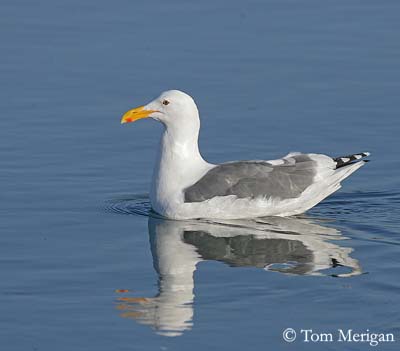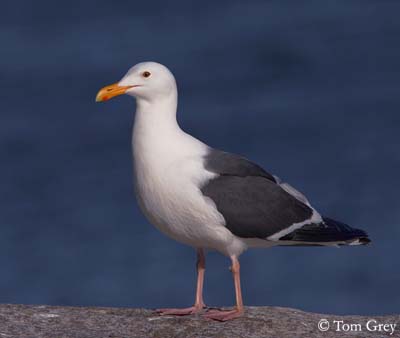
Western Gull
Larus occidentalis
Charadriiforme Order – Laridae Family
BIOMETRICS:
Length: 61-70 cm
Wingspan: 120-144 cm
Weight: 800-1250 g
LONGEVITY: Up to 25 years
DESCRIPTION:
All adults Western Gulls have white head with flat forehead, dark grey back, pink legs and very large yellow bill with red spot. Eyes are dark yellow.
Northern birds have paler backs and darker eyes than southern birds.
Dark grey wings have black tips. Underwing is white, but we can see a narrow grey band. Head and underparts are white. Tail is white.
Western Gull adult is four years old. Both sexes are similar, male larger than female.
PROTECTION / THREATS / STATUS:
Populations of Western Gulls have restricted range. They have often suffered from human disturbances.
Western Gull is very aggressive when it defends its territory, and consequently persecuted as a menace.
Western Gull is vulnerable to climatic events like hurricanes (El Niño) and oil pollutions.
Chick mortality is high, with only one surviving to fledging. Occasionally, abandoned chicks are adopted by other gulls.
Fr: Goéland d’Audubon
All : Westmöwe
Esp : Gaviota Occidental
Ital : Gabbiano occidentale
Nd : Pacifische Mantelmeeuw
Sd : Västtrut
Photographs by Tom Grey
His website :
Tom Grey's Bird Pictures
Photographs by Tom merigan
His website :
Tom Meriganís Photo Galleries
Text by Nicole Bouglouan
Sources:
HANDBOOK OF THE BIRDS OF THE WORLD Volume 3 by Josep del Hoyo-Andrew Elliott-Jordi Sargatal - Lynx Edicions - ISBN : 8487334202
FIELD GUIDE TO THE BIRDS OF NORTH AMERICA by National Geographic Society - National Geographic Society - ISBN: 0792274512
All About Birds (Cornell Lab of Ornithology)
Bird Web (Seattle Audubon Society)
What Bird-The ultimate Bird Guide (Mitchell Waite)
Wikipedia (Wikipedia, The Free Encyclopedia)

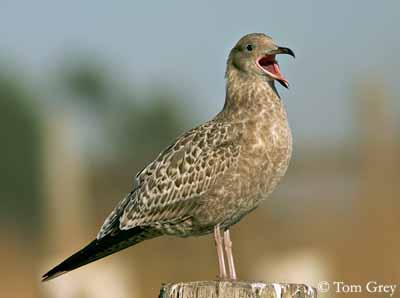
Juvenile is mottled brown, and has dark bill and eyes, greyish-pink legs, and dark tail.
The plumage varies every year.
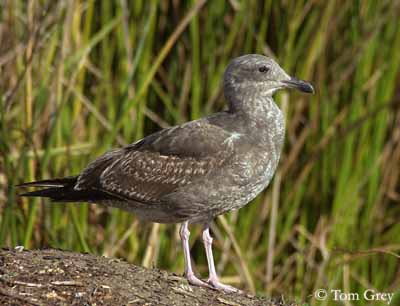
First winter is paler than juvenile, with pink legs, black bill, and dark tail.
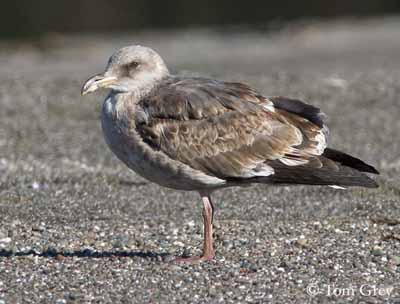
Second winter has dark grey back, yellow eyes, pale pink bill with black tip, and dark brown wings.
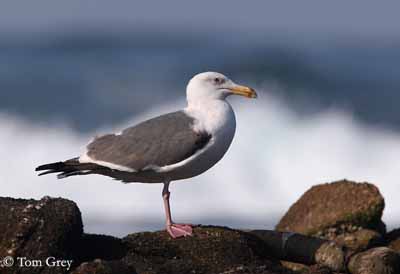
Third winter resembles adult, with two-toned bill and fine brown spots on head, nape, neck and breast, and partial tail band.
In winter, adult Western Gull has fine brown streaks on head.
Western Gull hybridizes extensively with Glaucous-winged Gull (Larus glaucescens) in the northwest. Breeding adult and first winter are paler than Western Gull, and darker than Glaucous-winged Gull, with black tips on wings in breeding adult plumage.
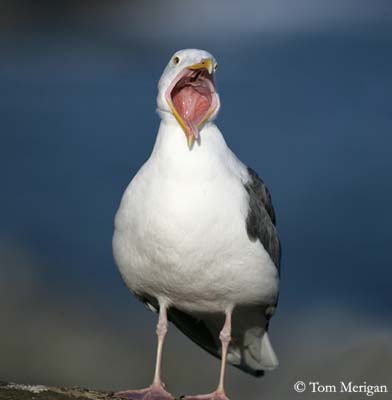
VOICE:
Western Gull’s call is a loud “keow”. First winter’s call is a rapid “quock-kuk-kuk-kuk”.
HABITAT:
Western Gull breeds on rocky islands. It lives near the coasts, in intertidal areas, beaches where it forages, and in dumps.
RANGE:
Western Gull breeds along Pacific coasts, from southern Washington to Central Baja California.
It winters from southern British Columbia to extreme southern Baja California.
BEHAVIOUR:
Western Gull is an opportunistic bird, stealing eggs and chicks of other species. They may also scavenge dead pups in sea lions colonies.
To eat some big shells, Western Gull drops the hard-shell item from the air, to break it on hard ground or rock.
It catches preys near water surface or on shore. It harasses food from other gulls and cormorants, forcing them to regurgitate. It may swallow large prey whole.
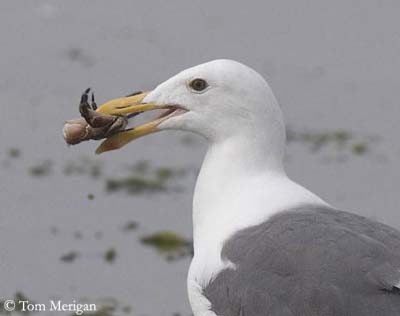
Western Gull is not shy. It is known to steal milk from female seals, when she lies on the back to sleep.
Western Gull is territorial and defends aggressively its territory. In the colonies, pairs defend their territories whose borders may change slightly from year to year, but territory is maintained for the life of the male.
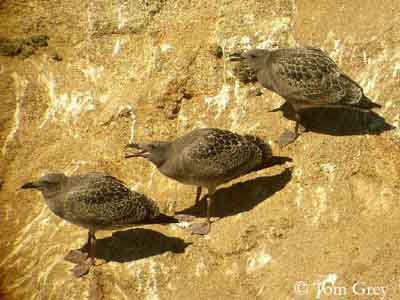
When there are many more females than males in a colony, two females may establish a pair bond. Each female lays eggs, and both take care of the double-brood.
Colonies are often located near seals and sea lions colonies, which provide food to the gulls.
FLIGHT:
Western Gull has rapid flight. Colours of underwings create a dark trailing edge, visible at great distance, when birds are out over sea.
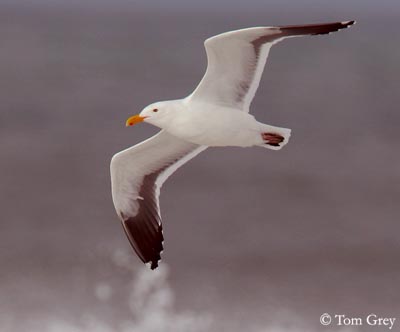
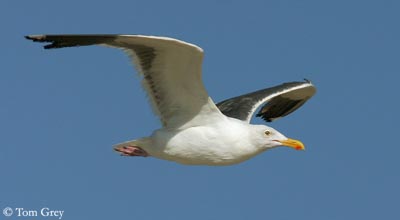
REPRODUCTION:
Western Gull nests in colonies, with other gulls species, on islands, offshore rocks or abandoned piers areas.
Nest is a scrape in the ground. It is lined with vegetation, feathers, rope, plastic…It is often situated near protection from the wind, rock or others objects, offering a barrier from neighbours.
Female lays 3 olive to cream-coloured eggs. Incubation lasts about 25 to 29 days, shared by both parents. Chicks hatch semi-precocial and may leave the nest at one day old, but generally, they leave the nest a few days after hatching, to hide into nearby vegetation.
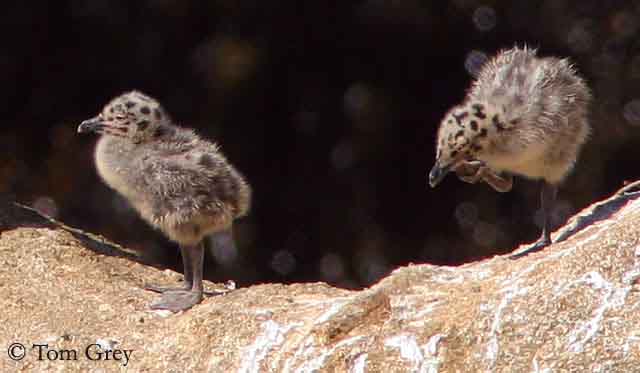
They begin to fly at 6 to 7 weeks of age. They become independent and leave the colony at about 10 weeks old.
Young reach their sexual maturity at 4 years old.
This species produces one clutch per year.
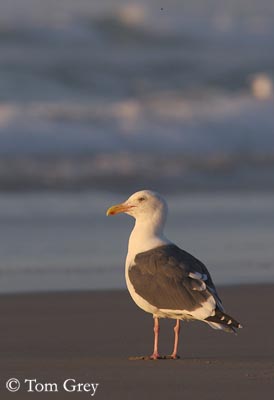
DIET:
Western Gull feeds in intertidal environment and at sea. It feeds on fish, marine invertebrates (krill, squid and jellyfish). Inland, it feeds on seal and sea lion carcasses, and cockles, limpets and snails in the intertidal areas.
It also takes food from people at piers and beaches.
